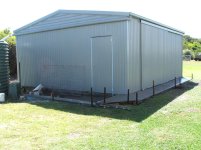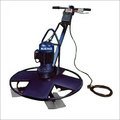alchemysa
Veteran Member
I recently concreted my shed. Size was 23 x 20 feet. (just a bit bigger than yours). Average depth was about about 4.5 inches. Including the path across the front it took 5 cubic metres at $230 a cubic metre. (5 metres is 6.5 cubic yards.) I used 5mm mesh as reinforcement. (6m x 2 metre sheets. 3 sheets at $60 a sheet). I think this will be ample strength for what I plan to park on it. Preparation is the key of course. You need to really pack the base down hard. Allow yourself a day at least to just spread the fill and level it and pack it down.
Don't underestimate how much concrete you need. It can be a disaster if you run short. (Its harder than you might think to get a consistent 5'' depth so allow for some variation.) Better to buy a truckload of concrete and have some extra formwork boarded up in case you have some leftover. As you can see from the pic I had formwork ready to concrete along the side of the shed. (Drat, now I'll have to mix that bit myself!).
You can do all the preparation but don't try and level the concrete yourself. Hire a guy who knows what he's doing. Its not a job for beginners. One 'professional' with a leveling screed and a motorised 'power trowel' is all you need to pay for. Apart from that, you and a buddy can man the wheelbarrows and of course there's the concrete driver who'll man the chute. 4 guys in total. Its not a big shed you are concreting so any more than that will just get in each other's way. If the job is straight forward then the truck will be on site for about an hour. The professional guy will screed (level) the concrete as you barrow or chute it in. It can be a relatively slow process. Its not simply a matter of dumping all the concrete in the middle of the shed and spreading it out.
You might also consider concreting a path at the front of the shed like I did. I'm really glad i did it at the same time rather than later. Its too small an amount to get delivered in a truck later on and it looks a lot more professional having a nice transition from inside to outside.
What surface finish do you want? I wanted a smooth finish inside so it would be easy to sweep. (Thats what the power trowel is for.) But the front path is a sponge finished so its non slip.
If you want a smooth finish count on the professional guy being there all day for a job like this. He has to wait quite a while for the concrete to go off before he can trowel it.
Don't underestimate how much concrete you need. It can be a disaster if you run short. (Its harder than you might think to get a consistent 5'' depth so allow for some variation.) Better to buy a truckload of concrete and have some extra formwork boarded up in case you have some leftover. As you can see from the pic I had formwork ready to concrete along the side of the shed. (Drat, now I'll have to mix that bit myself!).
You can do all the preparation but don't try and level the concrete yourself. Hire a guy who knows what he's doing. Its not a job for beginners. One 'professional' with a leveling screed and a motorised 'power trowel' is all you need to pay for. Apart from that, you and a buddy can man the wheelbarrows and of course there's the concrete driver who'll man the chute. 4 guys in total. Its not a big shed you are concreting so any more than that will just get in each other's way. If the job is straight forward then the truck will be on site for about an hour. The professional guy will screed (level) the concrete as you barrow or chute it in. It can be a relatively slow process. Its not simply a matter of dumping all the concrete in the middle of the shed and spreading it out.
You might also consider concreting a path at the front of the shed like I did. I'm really glad i did it at the same time rather than later. Its too small an amount to get delivered in a truck later on and it looks a lot more professional having a nice transition from inside to outside.
What surface finish do you want? I wanted a smooth finish inside so it would be easy to sweep. (Thats what the power trowel is for.) But the front path is a sponge finished so its non slip.
If you want a smooth finish count on the professional guy being there all day for a job like this. He has to wait quite a while for the concrete to go off before he can trowel it.


